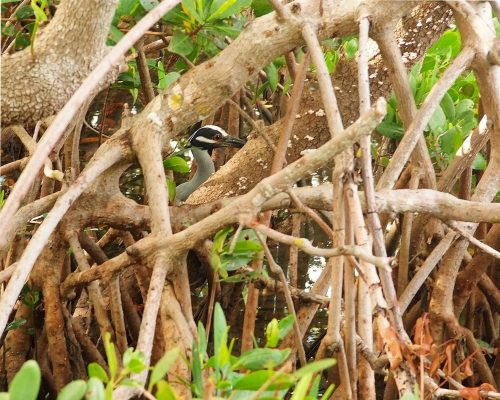— Florida Mangroves, A Native Story —
Florida mangroves, also known as walking trees, are native to Florida. There are four tree species that are considered mangroves. They are the red mangrove (Rhizophoraceae family), the black mangrove (Avicenniaceae family), and the white mangrove and Buttonwood (Combretaceae family). These trees all thrive in tidal zones and are very tolerant of saltwater and water level changes.
All mangroves can live in freshwater areas but have adapted to brackish areas after being out-competed by freshwater-only trees. Buttonwood and black and white mangroves have evolved to excrete the salt they absorb through salt glands at the base of their leaves. Red mangroves do not allow the salt to enter at all.
Mangrove trees produce seeds called propagules. The seeds will begin to germinate and grow roots while still on the tree. The seeds when mature, drop from the main tree and float away with the high tide. They will bobble on the root ball until they find a mudflat where they will attach and start growing into new mangrove trees.
Like many of Florida’s wildlife and plants, mangroves are now protected and it is illegal to destroy a mangrove tree. Human development and impact are the reason Tampa has lost over 44% of its coastal wetlands acreage which includes mangroves and marshes. Punta Gorda has lost 59% of the mangrove forest due to waterfront development. Lake Worth has experienced an 87% decrease in its mangrove acreage due to invasive Australian pines and urbanization.
What do mangroves do for Floridians? Mangrove forests protect uplands from storm winds, waves, and floods. The wider the mangrove area the more protection they give us. Mangroves can help prevent erosion by stabilizing shorelines with their specialized root systems, filter water, and maintain water quality and clarity. Florida has an average of 469,000 acres of mangrove forests.
Underwater, mangrove roots provide surfaces for various marine organisms to attach. The organisms feed off of organic materials, chemical elements, and nutrients that get trapped in the mangrove’s spider-like root system. The marine organisms are food for a multitude of marine species including snook, snapper, tarpon, jack, sheepshead, red drum, oyster, and shrimp. According to the Florida Department of Environmental Protection, Florida’s commercial and recreational fisheries would drastically decline without healthy mangrove forests.
Above water, Mangrove trees provide nesting areas for birds such as the wood stork, roseate spoonbill, brown pelican, and mangrove cuckoos. They provide a smorgasbord of crayfish, crabs, frogs, mice, small fish and snakes for a variety of birds.
So next time you see mangroves, take a closer look at the unique ecosystem right before your eyes. Appreciate the beauty, the wildlife who live within, and the protection the mangroves provide us when we retreat inland. While you are there pick up the trash that always gets caught in the mangrove roots. Together, we can enjoy our mangroves while making a difference for our wild friends and in our wild spaces.

